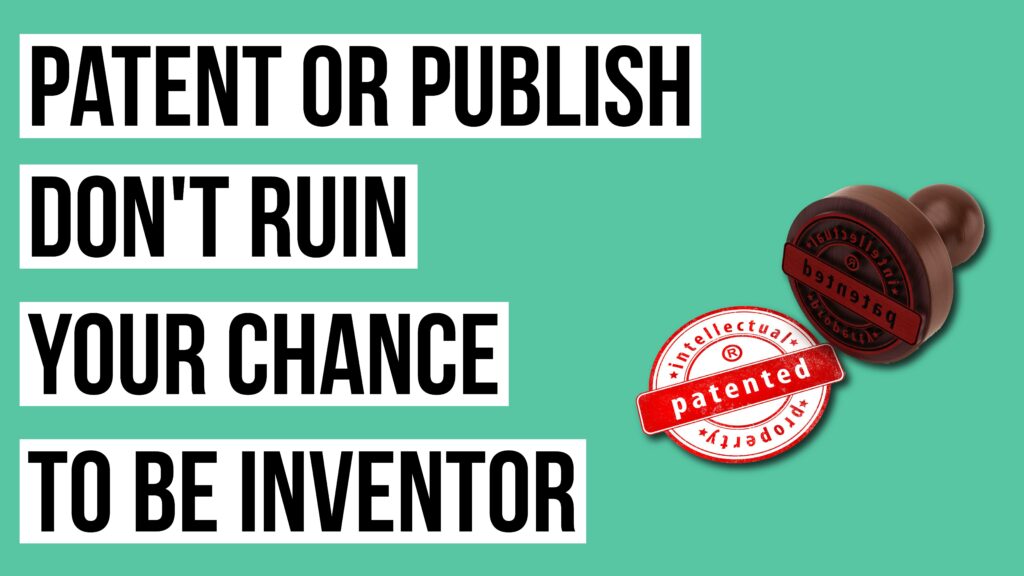Patent First, Publish Later: Don’t Ruin Your Chance of Being an Inventor

Finally, after months and months of hustle and hardwork, you discover that the finger wearable mouse or ring mouse that you have invented, actually works! Now you are in a state of utmost enthusiasm for writing a high quality research paper, preparing a good pesentation and getting an article published in the news or other media, on your invention. You might also find yourself wanting to start your own business with this very product as you feel that the world deserves to know about your brainchild. But hold on! Are you aware that if you publish your research or invention, present it, or discuss with an investor to fund it, you might actually be paving the path of your own loss? It is true that you are promoting your invention but doing so without protecting it with a patent can give other people access to using your invention without your permission. And within no time, you will be just another person who is manufacturing the same product.
This blog will be consciously dealing with an important topic that anyone in the IP industry is bound to face on a regular basis – what is more important, Patent or Publication. A question that is often asked by faculties and students is whether it is better to to get your research published or patented, because as seen mostly, published research gets more attention in our country as compared to the patented ones.
If an individial or a natural person, as patent law refers, or a company has invented a product or done a research, the Indian Patent Act 1970 itself guarantees protection of that. But that invention or research should fulfil 3 creterias – novelity, non-obviousness and industrial application.
However, you must keep in mind that if, even before filing for a patent, you have published or presented your research or invention, or brought it into the public domain in any way, it will not be eligible for a patent. If in case, you have got your paper published, you can be provided with patent protection, on filing for a patent, within 12 months from the date of publication. But in a situation where you are already using your invention or you have handed it over to a company, your invention will no longer be patentable as it is already visible to the public eye. For instance, let’s take the ring mouse I mentioned hypothetically in the beginning. If you give it to a company to for testing, or to a friend, or basically anyone, then it will be considered to be in public use.
It is true that the patent law gives us a time of 12 months to file for a patent after paper publication. But any patent attorney would suggest you to not do the same. This is because, when you publish a paper in which you write about your invention or research, it is obviously in the public domain. People from your field have access to reading it. There can be situations in which someone from your field reads your paper, modifies you designs and comes up with a similar invention and then files a patent for that. This would promote the new individual to be the owner of that design and it will no longer remain your original invention. This is why you must first get your research or ideas checked for patentability and then move further for publication.
There is a very commonly-used phrase in the field of science – “publish or perish”. This phrase has influenced scientists and researches largely, to get their inventions and researches published as soon as possible. In most universities in India, we can see a similar situation where the publication of paper is given the utmost priority and patenting is considered second. But many universities are working towards changing this as they are focusing more on patenting their research and invention before publishing them.
Why is Patent Protection so Crucial for you as researchers/faculties?
As an inventor/researcher, your most valuable asset is your research idea. Without a patent, anyone can copy your invention with complete liberty. In other words, your research or invention is your intellectual property and no one can use it without your permission; in any case, if a person dares to do so, you will have the complete right to stop them by taking legal actions. Patents give you full monopoly of your invention or discovery.
Another reason to patent your invention or research is that it helps you to benefit commercially from the invention and have gratifying financial returns, through licensing or technology transfer. Therefore, researchers must delay their publications at least until a patent application is filed.
I feel an example would be really suitable here.
There was a Professor who pioneered the technique of making roads with plastic waste; he is called the “Plastic man.”
We all are aware that plastic is one of the biggest problems in the world today as it not only harms the environment but also our health. But where there are great problems, there are great problem solvers! Therefore, one fine evening Prof. R. Vasudevan, on watching a TV show on how plastic polluted water bodies, got an idea to solve the issue. He developed a complete process of making roads with plastic and that is how he came to be known as the plastic man of India. He patented the technology of the process and in 2006, the Thiagarajar College of Engineering received the patent for this technology. Prof R Vasudevan is also a Padamshri awardee.
This instance highly talks about how he used his wisdom and got his technology patented before getting it published. This is something everyone must keep in mind and make sure to follow.